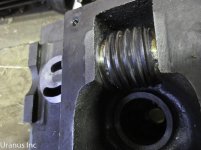farmersamm
Cast Iron
- Joined
- Feb 26, 2008
- Location
- oklahoma
Had a spindle chromed, and ground. They messed it up. No point into getting into the story, bottom line.....I'm stuck with a shaft that's about 2 tenths undersize at one journal. This journal holds a tapered roller bearing that has to move in order to set preload. But it's not supposed to move easily. It should be a light interference fit.
I could live with a few tenths if it was the original shaft material. 1137. I figure I'd just dimple the journal with a punch, and call it a day. I can't do this with chrome, I'm afraid it would start mud cracking at the punch location.
Okay, so I'm out of spec. Gotta live with it. BUT I NEED TO FIND A WAY TO KEEP THE INNER CONE FROM SPINNING ON THE SHAFT. The chrome is too slick to provide traction when side load is applied by the spindle pulley.
As far as I see it, I gots only a few options.
1. Either roughen the bearing bore, or the shaft journal, with a coarse stone.
2. Use 209 to keep it from spinning. Problem.....it's permanent until heated to 300 degrees to soften the bond. That ain't gonna work when I gotta set preload again later down the road. Once after initial run in, and again when the rollers start to wear.
209 is supposed to be the weakest locational adhesive out there, and they say it can be removed with conventional tools. Yeah, and I got some lake front property in a flood plain I'd like to sell ya
Yeah, I called tech support at Loctite. Dood just read me the product literature
I'm thinking that maybe I could just use a dab of this miracle stuff, instead of coating the entire journal. Enough to provide traction, but weak enough to come loose at a later date.
Anyways, hope y'all have had some experience with this stuff. Thanks
I could live with a few tenths if it was the original shaft material. 1137. I figure I'd just dimple the journal with a punch, and call it a day. I can't do this with chrome, I'm afraid it would start mud cracking at the punch location.
Okay, so I'm out of spec. Gotta live with it. BUT I NEED TO FIND A WAY TO KEEP THE INNER CONE FROM SPINNING ON THE SHAFT. The chrome is too slick to provide traction when side load is applied by the spindle pulley.
As far as I see it, I gots only a few options.
1. Either roughen the bearing bore, or the shaft journal, with a coarse stone.
2. Use 209 to keep it from spinning. Problem.....it's permanent until heated to 300 degrees to soften the bond. That ain't gonna work when I gotta set preload again later down the road. Once after initial run in, and again when the rollers start to wear.
209 is supposed to be the weakest locational adhesive out there, and they say it can be removed with conventional tools. Yeah, and I got some lake front property in a flood plain I'd like to sell ya

Yeah, I called tech support at Loctite. Dood just read me the product literature

I'm thinking that maybe I could just use a dab of this miracle stuff, instead of coating the entire journal. Enough to provide traction, but weak enough to come loose at a later date.
Anyways, hope y'all have had some experience with this stuff. Thanks









 In all likelihood, there's been a change to that metal. But twas broke to begin with, and can't get any broker
In all likelihood, there's been a change to that metal. But twas broke to begin with, and can't get any broker